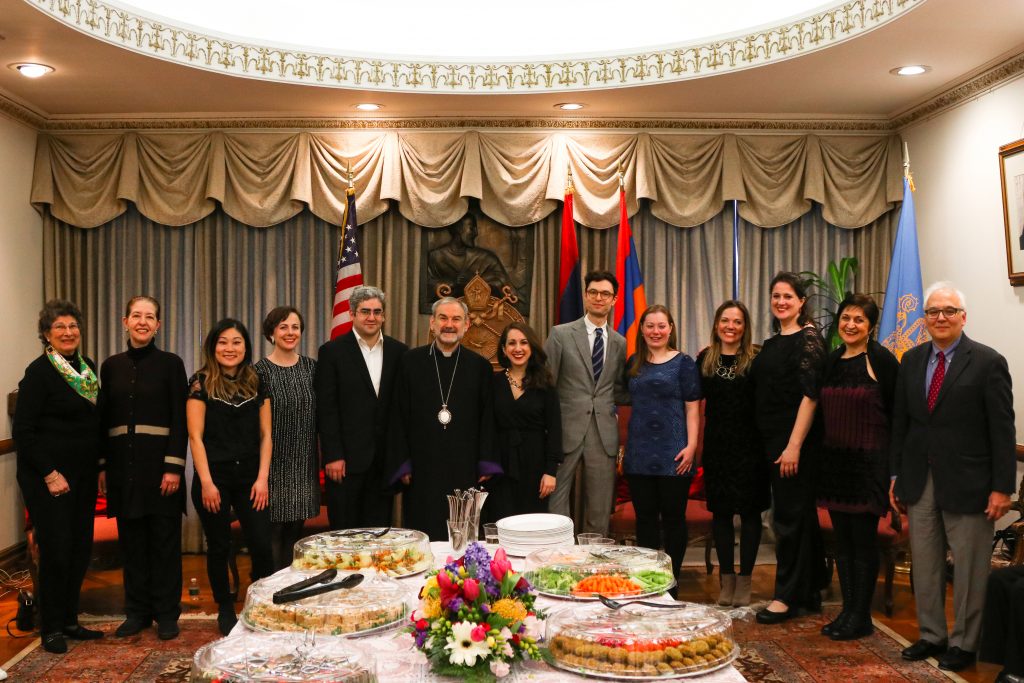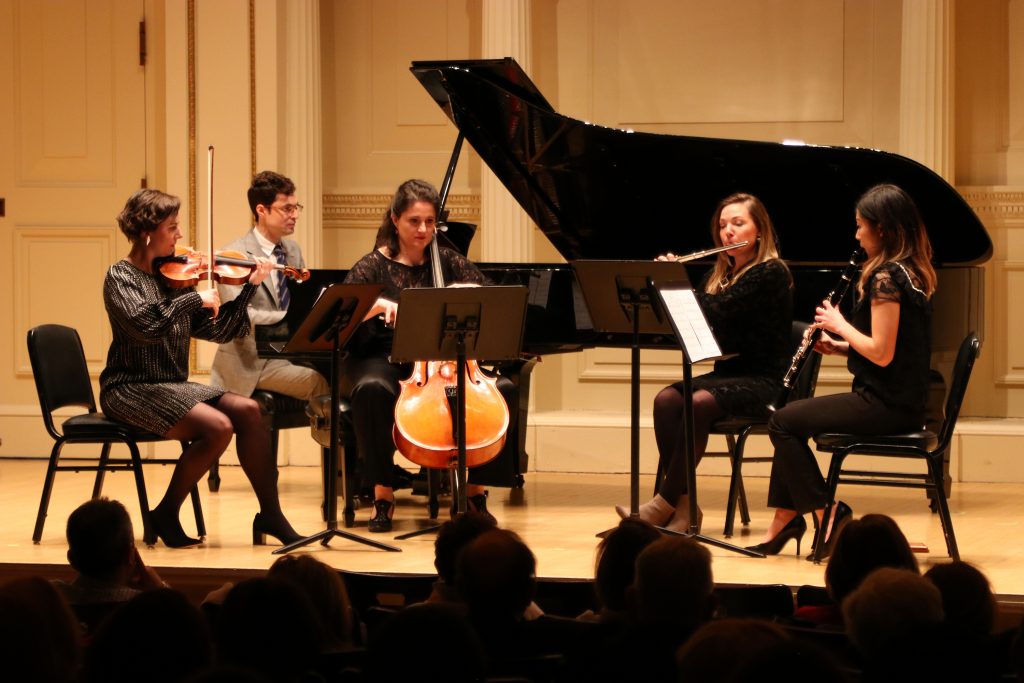NEW YORK—It was a unique musical event to celebrate a special anniversary. “Musical Armenia 35,” held at Weill Recital Hall at Carnegie Hall on March 18, had all the ingredients of a thrilling celebration—inspiring music by professional artists, recognition of a special anniversary, and a tribute to a dedicated, beloved individual.

Featured were pianist Hrant Bagrazyan (photographed) and the works of composer Mary Kouyoumdjian (Photo: Armenian Prelacy Eastern U.S)
Presented by the Armenian Prelacy (Eastern), Prelate Archbishop Oshagan Choloyan, and the Prelacy Ladies Guild, it was in celebration of the 35th anniversary of Musical Armenia, and featured prize-winning pianist Hrant Bagrazyan, and noted composer Mary Kouyoumdjian, whose dramatic, innovative works were performed by Jeffrey Gavett (baritone), Timo Andres (piano), and members of the Hotel Elefant ensemble.
The concert was dedicated to one of the Prelacy’s enduring and dynamic bright lights, Rita (Lulu) Tatevossian who devotedly served the Prelacy Ladies Guild for many years, and was a passionate promoter of Musical Armenia.
The Prelacy’s Vicar General Bishop Anoushavan Tanielian, representing Archbishop Choloyan who was out of the country, welcomed the enthusiastic crowd with Levon Tatevossian, son of Rita Tatevossian, calling her “one of the dedicated pillars of the Prelacy, full of life, sunshine and energy. She will always be remembered.”
Plays With Body and Soul
Before starting his performance, pianist Hrant Bagrazyan quietly bowed his head for a minute in contemplation. His program included three composers very different from one another. Arno Babadjanian’s “Six Pictures for Piano,” though highly improvisational, is replete with Armenian folk-nuanced melodies, changing rhythms, and colorful picturesque images.
Requiring a pianist of fearsome specialized skills, Bagrazyan showed his prowess as a technical wizard, his fingers dancing over the keys, and his body and facial expressions reflecting his emotions. The music ranged from the shattering and stormy “Improvisation” to the lyrically beautiful “Folk Song,” and “Sassoun Dance.”
Johann Sebastian Bach’s “Sheep may safely graze” from the “Hunting Cantata” which was originally written for a birthday celebration, has been arranged for different instruments. This piano transcription by Egon Petri, reflected Bagrazyan’s virtuosity, as did his interpretation of Maurice Ravel’s “Mirrors,” a richly dark, moody work replete with melancholy.
Following a lengthy ovation, the pianist to the delight of the audience, shared Komitas’ “Armenian Dance” as an encore, inflecting it with its joyous Armenian feeling.
Musical Chronicles of Joy and Despair
Following an intermission, four compositions by Mary Kouyoumdjian embodied her interest and involvement with significant somber pages in Armenian history. With each tragic saga, Kouyoumdjian painted vivid and creative musical images reflecting the emotional power of each story.
Providing the musical interpretations were guest artists, pianist Timo Andres, baritone Jeffrey Gavett, violist Gillian Gallagher, flutist Katie Cox, cellist Maria Bella Jeffers, clarinetist Isabel Kim, and violinist Andie Springer.
“Aghavni” (Doves, 2009) resonates with the happiness of life for a group of women before the genocide, and the subsequent horror and loss. “Everlastingness” from Gorky (2015), is an aria written on the life and death of renowned painter Arshile Gorky—his childhood memories of Armenia, his mother’s death from starvation during the Genocide, and his life in America with its series of tragic events. Lyricist Royce Vavrek described the song as a “fever dream as Gorky’s memories consume him.”
“A boy and a makeshift toy” from “Children of Conflict” (2015), is based on a young refugee playing in a train station filled with Albanian refugees waiting to be transported to another camp. And, “Sea of two colors” (2012), reveals a portrait of Komitas before and after the Genocide when he writes, “I have seen a black sea, and all around was white. The waves crashed but the two did not mix. Who has ever seen a sea of two colors?” from “Andouni” (Homeless).
At the conclusion of the concert, all performers acknowledged the standing ovation, as Levon Tatevossian came onstage and greeted each one with flower bouquets. The celebration continued at the Prelacy headquarters where the performers joined community leaders and members of the Musical Armenia committee and Prelacy Ladies Guild members.
Best among the Best
Welcoming the guests, Bishop Tanielian thanked the artists for “their interpretation and spirit,” and called the concert “very unique” because of the inclusion of a composer among the performers. He also paid tribute to the Musical Armenia committee members who “continuously choose the best among the best.” Addressing the performers, he commented, “You are ambassadors of God in one of the oldest arts—music, and you continue the heritage of the Armenian culture.”
For pianist Hrant Bagrazyan, the experience of performing at Carnegie Hall was the “ultimate honor. You are in that holy place where there is history in every corner of the building. To know that I performed where idols have played,” he said, his voice trailing off.
Armenia-born Hrant Bagrazyan studied at Yerevan State Conservatory where he was awarded an artist diploma. In the U.S., he received an M.A. degree in music from the Cleveland Institute of Music, and currently, is pursuing his doctoral degree in piano performance from Michigan State University. He was awarded a Bronze Medal at the Aram Khachaturian International Piano Competition in 2007, First Prize at the Kankakee Valley Symphony Orchestra International Young Artist Competition in 2014, and First Prize at the San Jose International Piano Competition in 2015. He has given concerts in Armenia, Belgium, Poland and the United States. Bagrazyan’s dreams include continuing his concert career, as well as teaching.
For Mary Kouyoumdjian, the concert was “special, but rare,” to have performed for an Armenian audience. “My music is inspired by my background. My parents came here as a result of the Lebanese Civil War. I wanted to be on stage writing my own music about things that I care deeply about, to give voice to those who are no longer here. Arts are a powerful medium to do so,” Kouyoumdjian said.
California-born Kouyoumdjian has an MA in film scoring and multimedia from New York University (NYU), and an MA in composition from Columbia University where she is pursuing her DMA. She has received commissions from the Kronos Quartet, Carnegie Hall, International Contemporary Ensemble, Brooklyn Youth Chorus, WQXR, the Nouveau Classical Project, Music of Remembrance, the Los Angeles New Music Ensemble, among others. Her work has been performed at Carnegie Hall, Lincoln Center, the Museum of Modern Art, and several music festivals.

A reception took place following the concert at the Prelacy offices. Shown above with Bishop Anoushavan are the featured artists Hrant Bagrazyan and Mary Kouyoumdjian, along with Hotel Elefant Ensemble, and Musical Armenia committee members. (Photo: Armenian Prelacy Eastern U.S)
Musical Armenia was established 35 years ago by Archbishop Mesrob Ashjian and the Prelacy Ladies Guild to “support young musicians of Armenian descent.” This year’s celebration received a generous sustaining donation by Armen and Janette Avanessians.
The beautifully prepared concert booklet with 35 years of historic photographs, and information, was under the direction of Prelacy Communications Director Iris Papazian, art designer Gregory Dosttur, and the Musical Armenia Committee members Julie Kedersha, Sophie Khachatryan, Varsenne Sarkissian, and Levon Tatevossian.
Members of the Prelacy Ladies Guild include Seta Andrikian, Sima Artinoff, Marion Boudakian, Linda Chirinian, Lilian Hairabedian, Gemma Melik Vartanian, Diana Minassian, Seta Nalbandian, Annie Pampanini, Lucille Sahagian, Anna Semerdjian, Silvia Setrakian, Nayda Voskerijian, Silva Zadourian.
The post The Prelacy’s ‘Musical Armenia 35’—A Thrilling Celebration appeared first on The Armenian Weekly.
Source: Armenian Weekly
Link: The Prelacy’s ‘Musical Armenia 35’—A Thrilling Celebration

